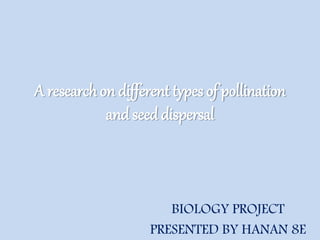
a ppt on polination and seed dispersal
- 1. A research on different types of pollination and seed dispersal BIOLOGY PROJECT PRESENTED BY HANAN 8E
- 2. PLANTS AND ANIMALS • Plants and animals need each other. It’s not hard to see why animals need plants most animals eat plants and cannot live without them. • Even animals that eat other animals are dependent on plants because without them their plant-eating prey would not exist. • Plants, on the other hand, make their own food with photosynthesis using sunlight, water and the carbon dioxide. • Yet if all the animals disappeared from the planet, most plants would disappear as well.
- 3. What is seed dispersal? • Seeddispersal is the movement or transport of seeds away from the parent plant. Plants have very limited mobility andconsequently rely upon a variety of dispersal vectors to transport their propagules, including both abiotic and biotic vectors.
- 4. Why do plants disperse? • Plant need to disperse their seeds away from themselves to stop overcrowding and to create new colonies. Nearly all seeds are produced within fruits . These fruits enable seeds to be dispersed in a variety ways .
- 5. Why does this happen? • Plants need help to pollinate and spread their seeds. Some plants about 10% use the wind for pollination from the mightiest redwood to the smallest blade of grass. Yet most plants the help of animals to get the job done
- 6. The Pollination situation • Some plants are pollinated by birds – like the hummingbird. A few are pollinated by bats. But by far, more plants are pollinated by insects than anything else. • Plants have adapted many traits to attract pollinators. • Bright colored blossoms attract bees, flies, butterflies, and moths inside to collect nectar and pollen. • Sometimes lines on their petals will guide the insects down into the blossom or a sweet smell will attract pollinators from a long way off.
- 7. How does this happen ? • In turn, moving from blossom to blossom, collecting nectar • The insects spread the plants pollen to other blossoms on that plant and others nearby. • Most plants are not picky about who pollinates them and have open flowers with ray or disc blossoms – like asters, daisies or black-eyed Susans – where any insect can land, collect nectar and carry pollen on to another flower
- 8. The honeybee and the tree foil pea • Some plants, however, want just one type of insect to pollinate them. This is true of birds foot trefoil. Birds foot trefoil is a common pea plant grown all over North America for feeding livestock and covering farm fields. • Though common, it has a complicated flower, making it difficult to get inside to collect nectar or pollinate. • Only bees can figure out how to enter a birdsfoot trefoil blossom and the honeybee is especially good at it.
- 9. How does it works ? • Whena honeybeelandsona birdsfoottrefoilblossom,it looksfornectarinsidethetoppetal, called theflag,becauseit hasguidinglinespointingto itsbase,butthe nectarisn’tthere. • Whileit standson thefusedsidepetalslookingfornectar, thebee’sfeetworkthepetalsopen exposinga keelpetalinside. • Whenthebeestepsdownontothekeel,itsweighttriggersthe keelto bouncedown likea trampoline, andthepetalsspread. • Thenthestamensinsidethekeelthatarecoveredwithpollenwillpopup anddustthebee’sbelly. • If thebeehasbeento anotherblossomalready,thepistol, whichalsotouchesthebeesbelly,getsa doseof thepollenalreadystuckthere.Pollinationhasoccurred!
- 10. Wonder why? • Some might wonder what the advantage is of having only one kind of insect to pollinate a plant. Why wouldn’t the plant want every insect that lands on it to pollinate it? • Some scientists hypothesize that when a honeybee finds a flower where the nectar is ready, it signals the other bees and they all come to collect nectar at once so a lot of pollination occurs. • A difficult flower makes it more likely that the nectar will be there for a visiting honeybee